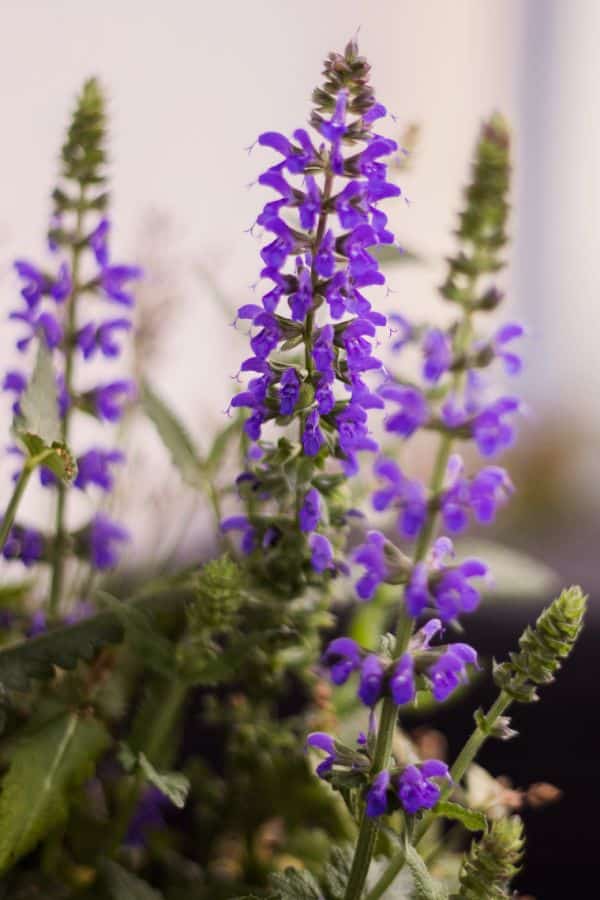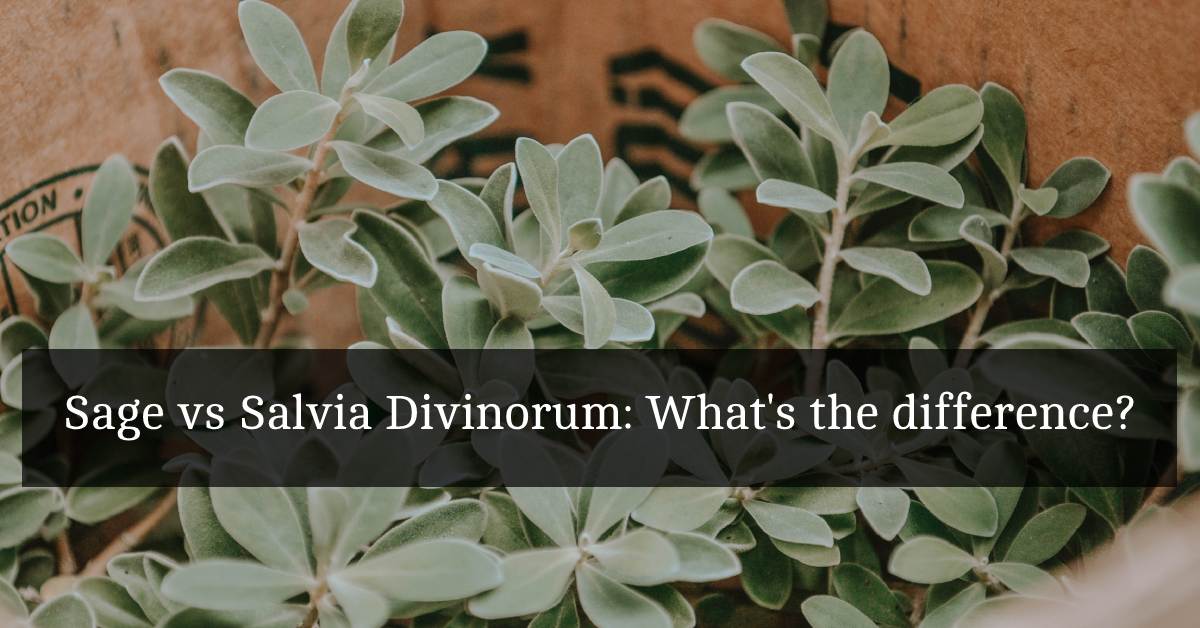Salvia is a genus of plants that is commonly known as sage. There are over 900 species of sage, with two of the most well-known species being Salvia officinalis and Salvia divinorum. While both of these plants share the common name of sage, they are vastly different from one another in terms of their properties, uses, and effects. In this article, we will explore the differences between Salvia officinalis and Salvia divinorum.
Salvia Officinalis
Salvia officinalis, commonly known as culinary sage or common sage, is a perennial herb that is native to the Mediterranean region. It is a member of the mint family, Lamiaceae. The plant has a woody stem that can grow up to 2 feet tall, and it produces gray-green leaves that are covered in a fine layer of hairs. The leaves of Salvia officinalis have a strong, earthy aroma and a slightly bitter taste.

Salvia officinalis has been used for culinary and medicinal purposes for centuries. The herb is often used as a flavoring agent in dishes like stuffing, sausages, and soups. It is also used in traditional medicine to treat a variety of ailments, including digestive issues, respiratory problems, and inflammation.
In addition to its culinary and medicinal uses, Salvia officinalis has also been used in aromatherapy. The essential oil of the plant is extracted from the leaves and used in diffusers, massage oils, and beauty products.
Salvia Divinorum
Salvia divinorum, also known as Diviner’s Sage or simply Salvia, is a species of sage that is native to Mexico. Unlike Salvia officinalis, which is primarily used for culinary and medicinal purposes, Salvia divinorum is a psychoactive plant that is used for spiritual and shamanic practices.
The plant has large, green leaves that are heart-shaped and covered in fine hairs. It can grow up to 3 feet tall and produces small, white or purple flowers. Salvia divinorum contains a psychoactive compound called salvinorin A, which is responsible for the plant’s hallucinogenic effects.
Salvia divinorum has been used for centuries by indigenous cultures in Mexico for spiritual and shamanic practices. The plant is typically consumed by smoking, chewing, or drinking a tea made from the leaves. The effects of Salvia divinorum are intense and short-lived, typically lasting between 5 and 30 minutes. Users report experiencing vivid hallucinations, altered perceptions of reality, and an overall sense of euphoria.
Differences Between Salvia Officinalis and Salvia Divinorum
While both Salvia officinalis and Salvia divinorum are members of the sage family, they differ significantly in their properties, uses, and effects. Here are some of the key differences between the two plants:
- Properties
Salvia officinalis is a culinary and medicinal herb that has a strong, earthy aroma and a slightly bitter taste. The plant is not psychoactive and does not contain any hallucinogenic compounds. Salvia divinorum, on the other hand, is a psychoactive plant that contains salvinorin A, a potent hallucinogen.
- Uses
Salvia officinalis is primarily used as a flavoring agent in culinary dishes and as a medicinal herb to treat a variety of ailments. It is also used in aromatherapy. Salvia divinorum, on the other hand, is used for spiritual and shamanic practices. It is consumed for its hallucinogenic effects and is not used for culinary or medicinal purposes.
- Effects
The effects of Salvia officinalis are primarily related to its medicinal properties.
The plant has anti-inflammatory, anti-bacterial, and antioxidant properties, and it is commonly used to treat conditions like indigestion, sore throat, and inflammation. The effects of Salvia divinorum, on the other hand, are psychoactive and can result in vivid hallucinations, altered perceptions of reality, and an overall sense of euphoria.
- Legality
Salvia officinalis is legal and widely available for culinary and medicinal purposes. It is a common herb that can be found in grocery stores, health food stores, and online. Salvia divinorum, on the other hand, is a controlled substance in many countries, including the United States, Canada, and most of Europe. In some countries, it is completely illegal to possess, sell, or use Salvia divinorum.
- Cultivation
Salvia officinalis is a relatively easy plant to grow and is commonly cultivated in gardens and farms. It can be grown from seed or from cuttings, and it thrives in warm, dry climates. Salvia divinorum, on the other hand, is a more difficult plant to grow and requires specific conditions to thrive. It is typically grown in specialized facilities or by experienced growers.
- Side Effects
While Salvia officinalis is generally considered safe for culinary and medicinal use, it can cause side effects in some individuals. These may include stomach upset, dry mouth, and skin irritation. Salvia divinorum, on the other hand, can cause more serious side effects, particularly when consumed in high doses. These may include dizziness, confusion, paranoia, and loss of coordination.
Conclusion
In conclusion, Salvia officinalis and Salvia divinorum are two very different plants with distinct properties, uses, and effects. While Salvia officinalis is a culinary and medicinal herb that is commonly used in cooking and aromatherapy, Salvia divinorum is a psychoactive plant that is used for spiritual and shamanic practices. The two plants differ significantly in their chemical composition, effects on the body, and legal status.
It is important to note that while Salvia officinalis is generally considered safe for culinary and medicinal use, Salvia divinorum is a powerful hallucinogen that can have serious side effects, particularly when consumed in high doses. It is important to use caution when consuming any plant or substance, and to only use them under the guidance of a qualified professional.
Ultimately, the differences between Salvia officinalis and Salvia divinorum highlight the incredible diversity of the plant kingdom and the wide range of properties and effects that different plants can have on the body and mind. By understanding these differences, we can better appreciate and utilize the unique properties of these fascinating plants.
Sources
- American Herbal Pharmacopoeia. (2016). Sage Leaf: Salvia officinalis L. monograph. Retrieved from https://herbal-ahp.org/wp-content/uploads/2016/12/Sage-Leaf-Monograph-2016.pdf
- National Center for Complementary and Integrative Health. (2020). Sage. Retrieved from https://www.nccih.nih.gov/health/sage
- Klemow, K. M., Rayburn, A. P., & Klemow, T. E. (2015). Salvia divinorum: Botany, pharmacology, and toxicology. HerbalGram, 108, 52-63.
- Valdés III, L. J., Hatfield, G. M., Koreeda, M., & Paul, A. G. (1987). Studies of Salvia divinorum (Lamiaceae), an hallucinogenic mint from the Sierra Mazateca in Oaxaca, Central Mexico. Economic Botany, 41(2), 283-291.
- Johnson, M. W., MacLean, K. A., & Griffiths, R. R. (2008). Potential therapeutic effects of salvia divinorum and its active constituent salvinorin A: a review. Journal of Psychopharmacology, 22(8), 820-832.
- Cakir, A., & Kordali, S. (2010). Screening of chemical composition and antifungal and antioxidant activities of the essential oils from three Salvia species. Journal of Agricultural and Food Chemistry, 58(6), 3850-3855.
- Ernst, E. (2002). Herbal medicinal products during pregnancy: are they safe? BJOG: An International Journal of Obstetrics & Gynaecology, 109(3), 227-235.
- Benowitz, N. L., & Jacob III, P. (2014). Metabolism of nicotine. In Nicotine psychopharmacology (pp. 29-56). Springer, Berlin, Heidelberg.
- Chen, T. B., & Zeng, L. X. (1999). Chemical constituents of Salvia divinorum. Acta Botanica Yunnanica, 21(3), 319-322.
- Cunningham, A. B. (2001). An ecological and cultural overview of salvia divinorum (Lamiaceae). Economic Botany, 55(1), 104-117.
- Swogger, M. T., Walsh, Z., Addy, P. H., & Khey, D. N. (2015). A mixed methods analysis of experiences with Salvia divinorum: preliminary results. Journal of Psychoactive Drugs, 47(1), 17-26.



